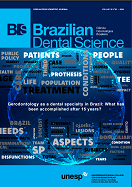Root resorption after dental trauma in permanent molar: a 5-year follow-up
DOI:
https://doi.org/10.14295/bds.2016.v19i2.1175Abstract
Introduction: There is low incidence of trauma in posterior teeth, and their complications are rarely reported in the literature. This report describes a case of internal root resorption with communication with the periodontal area as a result of traumatic dental injury of a permanent molar tooth. Case Report: The treatment consisted of chemo-mechanical preparation and the use of calcium hydroxide as intracanal medication, followed by filling and sealing of the resorption area with mineral trioxide aggregate. Results: After 5 years of follow-up, the tooth was in function, without signs or symptoms and the resorption area was repaired. Conclusion: We emphasize the importance of follow-up in cases of dental trauma, even in cases of low severity, such as subluxative injury, in order to predict possible sequelae in advance. The correct approach to treatment of the resorption area and sealing with mineral trioxide aggregate ensured the successful outcome of the case.
Keywords
Molar; Permanent dentition; Tooth injuries; Root resorption.
Downloads
Downloads
Additional Files
Published
How to Cite
Issue
Section
License
Brazilian Dental Science uses the Creative Commons (CC-BY 4.0) license, thus preserving the integrity of articles in an open access environment. The journal allows the author to retain publishing rights without restrictions.
=================




























